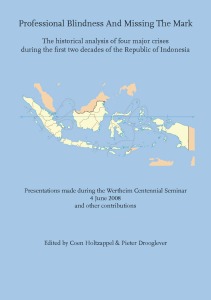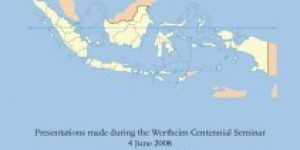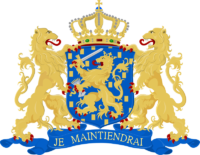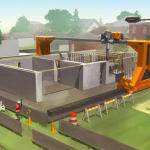Professional Blindness And Missing The Mark ~ The Anthropologist’s Blind Spots: Clifford Geertz On Class, Killings And Communists In Indonesia
No comments yet When I first went to Indonesia for research in 1972, I was not well prepared at all. The decision to go to Indonesia had been made at short notice. Soon after I discovered that I would not be allowed to go to Burma, I met Clifford Geertz after he had given a lively seminar at Columbia University and he suggested that I shift my interests to Indonesia. Like many graduate students of this era I had been impressed by Geertz’s Agricultural Involution (1963a). Unlike PhD candidates from universities with strong traditions of teaching and research on Indonesia like Leiden, Wageningen, Amsterdam, Cornell, Berkeley or Yale I had taken no courses in Indonesian studies, knew only a few words of Indonesian language, and had read only a very few books on Indonesia. Among them was a curious and disturbing booklet called Indonesia 1965: The Second Greatest Crime of the Century (Griswold 1970). This booklet gave stark details of the orchestrated anti-Communist backlash after the crushing of a bungled leftist coup attempt in Jakarta (in which twelve persons in total had been killed) and the massacre of hundreds of thousands of alleged communists and communist sympathizers in Java and Bali in late 1965 – early 1966. It also gave a quite different version of the background and course of the massacres than what was to be found in the US Government Printing Office’s semi-official Area Handbook for Indonesia.
When I first went to Indonesia for research in 1972, I was not well prepared at all. The decision to go to Indonesia had been made at short notice. Soon after I discovered that I would not be allowed to go to Burma, I met Clifford Geertz after he had given a lively seminar at Columbia University and he suggested that I shift my interests to Indonesia. Like many graduate students of this era I had been impressed by Geertz’s Agricultural Involution (1963a). Unlike PhD candidates from universities with strong traditions of teaching and research on Indonesia like Leiden, Wageningen, Amsterdam, Cornell, Berkeley or Yale I had taken no courses in Indonesian studies, knew only a few words of Indonesian language, and had read only a very few books on Indonesia. Among them was a curious and disturbing booklet called Indonesia 1965: The Second Greatest Crime of the Century (Griswold 1970). This booklet gave stark details of the orchestrated anti-Communist backlash after the crushing of a bungled leftist coup attempt in Jakarta (in which twelve persons in total had been killed) and the massacre of hundreds of thousands of alleged communists and communist sympathizers in Java and Bali in late 1965 – early 1966. It also gave a quite different version of the background and course of the massacres than what was to be found in the US Government Printing Office’s semi-official Area Handbook for Indonesia.
During my stay in Indonesia I found little to read, and few people willing to talk, about the killings or the events of 1965-66 more generally. In the village in Kulon Progo (Yogyakarta) where I lived during 1972-73 there had been no killings, although people were aware that there had been killings in other parts of the district. On two visits to Jakarta the confident young expatriate staff of the Ford Foundation – always a good source of gossip – seemed to hold to a version of the events of 1965-66 that was close to that of the Area Handbook and the Indonesian government.
When I returned to New York and had decided more or less to make myself into an Indonesia expert, I was of course curious to learn more. One of the first authors I turned to, not surprisingly, was Clifford Geertz. Besides numerous articles and chapters on Indonesian religion and rural society, Geertz had published five books on Indonesia during the years 1960-1968: The Religion of Agricultural Involution, Peddlers and Princes, The Social History of an Indonesian Town, and (after new fieldwork in Morocco in 1963) Islam Observed: Religious Development in Morocco and Indonesia. He had also edited a sixth book, Old Societies and New States (Geertz, 1963c), on politics in the newly-independent countries of Asia and Africa, which included his much-quoted essay ‘The Integrative Revolution: Primordial Sentiments and Civil Politics in the New States’. He was, simply, the world’s best-known authority on post-colonial Indonesian society at the time, and it was hardly possible to discuss any aspect of Indonesian society, culture or politics without reference to Geertz’s work.
Geertz had undertaken long periods of field research in both Kediri (East Java, 1953-4) and Bali (1958), two regions in which the bulk of the killings had occurred and which had been marked by violent political conflicts both before and after his fieldwork.
While his long field visits both took place several years before 1965-66, a few years after the massacres Geertz had the opportunity to revisit both his Balinese and Javanese field research sites. In his Balinese field research village, he learned that the killings had taken place in a single night, when 30 families were burned alive in their houses; in Pare (Kediri) the killings had gone on for about a month (Geertz 1995: 8).
In 1971, while on a consulting mission for the Ford Foundation, Geertz had spent time in social science faculties on several Indonesian university campuses; in some of them as many as one-third of all staff had lost their jobs in the anti-communist purges of 1966-7. During this visit he had also spent time in Jakarta as guest of the Ford Foundation, an agency which, having close connections to the US embassy and the CIA as well as the Indonesian military and cabinet, was well in touch with the emerging facts about the involvement of the US government and the Indonesian army in orchestrating the anti-PKI campaigns of 1965-66.
For all these reasons, Geertz was, at that time, probably as well informed as any foreign scholar about the actors and processes of Indonesia’s massacres, both at national and at local level. Like many others, I expected that Geertz would sooner or later decide to put this knowledge to use in one of the typical, reflective essays for which he had become so famous, to help us understand this extraordinary and dreadful tragedy in Indonesia’s post-colonial experience. So far as I know, however, no such essay exists. In the twenty years that followed the killings Geertz alluded to them in only a few scattered references.
Geertz’s avoidance of any serious discussion of the Indonesian mass murders of 1965–66, and what they mean for our understanding of Indonesian politics, is both puzzling and revealing. This does seem to be a good example of what Wertheim in his later years called the “sociologists’ blind spots”, or the “sociology of ignorance” [Wertheim (1984) (1975)]. One dimension of this, about which Wertheim has written, is Geertz’ chronic blindness to class inequalities in Javanese society. Many young researchers of the 1970s, both Indonesian and foreign, had become convinced that the picture of harmonious, poverty-sharing village communities established in such writings as Agricultural Involution was not right. As Wertheim remarked, Geertz’s vision of rural Javanese society mirrored the blindness of colonial and post-colonial élites, whose idea of the harmonious and homogeneous village community was derived from, and promoted by, the village élite themselves (Wertheim 1975: 177-214; cf. Utrecht 1973: 280). There is certainly a striking lack of fit between Geertz’s accounts of Javanese homogeneous rural and small-town culture and the many violent political conflicts in the region both before and after his fieldwork.
But the few scattered comments on the killings which Geertz did make during these years (and which we will summarize below) suggest also the weaknesses of a reliance on cultural explanations of Indonesian collective political violence. This was the type of explanation prevailing at the time among Western media and semi-popular authors; an outbreak of mass communal frenzy, based on pent-up resentment at the leftists’ undermining of core (Balinese or Javanese) values of harmony and order. In most accounts, the killings burst suddenly on the scene, and then stopped just as suddenly; see for example the accounts of journalist John Hughes (1967), Rand Corporation and CIA author Guy Pauker (1968) or the later memoirs of Marshall Green, who had been US Ambassador in Jakarta at the time of the coup (Green 1990).
In 1966, in a short article called “Are the Javanese mad?” Geertz had criticized one type of (psycho) cultural explanation, as offered by Herbert Luethy. Geertz alluded to an estimate of 100,000 dead (following the US embassy’s estimates, to be seen in the now-declassified US Department of State archives). In 1972, in an after word to the edited book on Culture and Politics in Indonesia (Holt, Anderson and Siegel 1972) – a book whose chapters do not mention the killings, having been written some years earlier – Geertz alludes to a quarter of a million killed, showing again that he was aware of the emerging reports and new estimates; he offers little by way of explanation but writes a general defense of ‘cultural’ theories of Indonesian politics, the general idea that “a country’s politics reflect the design of its culture” (Geertz 1972:319). The savage aftermath of the bungled October 1 coup, he writes “brought to open view the cultural disarray fifty years of political change had created, advanced, dramatized, and fed upon”. He also remarks that none of the eruptions of great domestic violence seen in the Third world (in India, the Congo, Biafra, Jordan) have been “more shattering than the Indonesian, nor more difficult to evaluate” (1972: 332).
The following year, in a 1973 postscript to his (pre-1965) article on primordialism, Geertz described the “several months of extraordinary popular savagery […] directed against individuals considered to be followers of the Indonesian communist party […] Several hundred thousand people were massacred, largely villagers by others villagers (although there were some army executions as well) and in Java at least, mainly along … primordial lines — pious Moslems killing Indic syncretists” (Geertz, 1973: 282).
In the same year Geertz wrote a chilling footnote, almost an aside, in the landmark ‘cockfight’ article on Bali, where the killing had been relatively more severe than in any other region:
“That what the cockfight has to say about Bali is not altogether without perception and the disquiet it expresses about the general pattern of Balinese life is not without reason as attested to by the fact that in two weeks of December 1965 […] between forty and eighty thousand Balinese (in a population of about 2 million) were killed, largely by one another [..] This is not to say, of course, that the killings were caused by the cockfight, could have been predicted on the basis of it, or were some sort of enlarged version of it with real people in place of the cocks – all of which is nonsense. It is merely to say that if one looks at Bali … also through the medium of its cockfights, the fact that the massacre occurred seems, if no less appalling, less like a contradiction to the laws of nature” (ibid.: 452).
For those who manage to find their way through this tortuous prose, it is clear that Geertz is suggesting that the killings do somehow express the same deep, suppressed cultural lust for cruelty and violence that he had discerned in the Balinese cockfight.
Such ‘cultural’ accounts of the massacres, in both Java and Bali, became increasingly untenable as the years passed and more information became public. There is a stark contrast between Geertz’s apparent ignorance or blindness on these events, and the careful explorations and analyses of the killings at local or regional level by other scholars, like Robert Hefner (1990, Ch. 7) and Geoffrey Robinson in Bali (Robinson 1995). On Bali, Geoffrey Robinson’s historical account of political conflict along class, caste and ideological lines offers a powerful counterpoint to aliran- and ‘primordiality’-centred views (Robinson, 1995; Sidel, 1997). Robinson, and more recently John Roosa have shown clearly that the army was not only present at, but actively orchestrated the killings, whose onset coincided with the army’s eastward progress through Central and East Java and Bali. The killings were supported by a powerful propaganda machine which disseminated myths about the depravity of communist men and women, and the existence of death-lists drawn up by the PKI: “it is clear that the military bears the largest share of responsibility and the killings represented bureaucratic, planned violence rather than popular, spontaneous violence” (Roosa, 2006: 28).
It was about three decades after the massacres that Geertz finally wrote more than a few lines about the killings, devoting a few pages to a description of the killings in and around Pare in the autobiographical book After the Fact (1995). By this time quite a number of authors had written accounts of the killings in the Kediri region, some based on first-hand experience (for example Walkin 1969; Rochijat 1985 ; Young 1990). Geertz had read, and cites (1995: 172 n.7), Young’s account and Cribb’s edited volume (1990) which summarized available information on the killings.
In the light of what was known by the mid-1990s in these and other publications (which, as already noted, Geertz had certainly read) Geertz’s general account of the character of the conflicts and killings in Java and Bali is quite extraordinary:
“The failure of the palace guard coup in Jakarta at the end of September 1965 […] led to a series of small-scale iterations of it as its example spread, place by place, across Java and on to Bali, west to east. In each place there was the initial uncertainty, lasting a day or two at most, about which way things would go. Then there was the realization on all sides, usually in the space of hours, as to which way, always the same way, things would go. Then there were the killings, halted after a while by the army” (1995: 8)
The idea that the Jakarta coup was replicated all over Java and Bali in a series of mini-coups initiated by leftists, – and that the killings of communists were therefore a response to earlier communist aggression – is unique to Geertz, and bizarre. The bold statement that the army’s role was to halt the killings – with no mention of their role in starting them, and in the killing itself – is also extraordinary.
Geertz’ account of the killings in Pare relies mainly on the 1971 account of a retired Nationalist Party leader, reproduced verbatim in a long, two-page quotation. From the old man’s account, the army’s involvement in, and orchestration of, the killings was clear.
“The whole population of a village would be herded onto the public square in front of the District Office by the army. They were then told to point out who was an activist and who was not. The activists were then delivered back to the people to take home and execute, or, more often, handed over to people of neighboring villages in exchange for their victims…
“In the beginning, things could have gone either way. Each side was trying to kill the other side first, and when the Communists saw that the Muslims had the upper hand, they just gave up. There was no resistance from the Left at all, once the killings began. The army … just let the Muslim youth have their head, at least for a while, after which they called a halt and began just arresting people and carting them off to Buru [a prison island in eastern Indonesia] or somewhere” (Geertz, 1995: 10).
In relaying the old nationalist’s account — the only version that Indonesians were permitted to parrot under the new regime — without critical comment, Geertz appears virtually to endorse the official view of the Indonesian army and the CIA, that it was a matter of ‘kill or be killed’, that the slaughter of Communists was a matter of self-defense in the face of Communist aggression, and therefore justified (Reyna, 1998). Accounts of such contested matters, however, require critical interpretation, which means the ethnographer has to be more than ventriloquist of his informants, but to reflect on their statements and why they may have given a particular account, and to have – or at least, to help the reader arrive at – a point of view.
What causes sociological blindness? To answer this question, we should not only look to the author’s personal politics, but also to the limitations of his analytical framework. In general, Geertz had avoided the trend in the 1970s to place issues of class, power and history more centrally in anthropology, and had stuck to a vision of cultures as systems of locally-shared symbols (and associated practices), blinding him to questions of social differentiation, social conflict, and associates negotiations and contestations over meanings. When this variety of ‘interpretive anthropology’ confronts the evidence of army orchestration of, and significant foreign intervention in, a multi-sited mass murder of these proportions, local cultural explanations are at best auxiliary, and at worst redundant, as Adam Kuper has observed.
“Geertz was surely aware of these external forces, but his analytical framework could not cope with the interplay of local, national and international politics. These matters were beyond the scope of ‘local knowledge’. The coup in the capital […] had little to do with the local cultural and political trends that were evident in Mojokuto. Nor can the violence that it triggered even in remote areas be explained purely in local terms. [..] The massacres began only after the soldiers had spread across the country and encouraged violence, even supervising the killings. They exploited local hatreds, and found willing collaborators, but there would have been no countrywide massacres without their intervention […] More generally, these terrible events expose the limitations of a cultural analysis of politics” (Kuper, 1999: 95-6)
For young generations, inside and outside Indonesia, who wish to learn and reflect on Indonesian history and society, these issues are still important; Reformasi has not removed the state-enforced ‘ignorance’ of the events of 1965-66. In March 2007 Attorney-General Abdul Rahman Saleh ordered the banning and burning of fourteen history textbooks, which had challenged “accepted facts” by not stating that the PKI was responsible for the September 30th Movement. Meanwhile, numerous history texts that do not even mention the killings are approved and available in bookshops (Tan, 2008).
Sociological ‘ignorance’ and ‘blind spots’ are perhaps too passive as metaphors for what has been discussed here, where the researcher/author is not unaware of things but makes a choice not to include them in his frame of reference. The blind and the ignorant, in general, are not busy making themselves or others blind and ignorant; what Wertheim drew to our attention, in contrast, was a process by which elites, and scholars, choose to describe societies and history in ways which make both themselves and others blind to social reality.
REFERENCES
Asad, Talal, ‘Anthropological conceptions of religion: reflections on Geertz’ Man’, in: Journal of the Royal Anthropological Institute 18-2 (1983), pp. 237-59.
Cribb, Robert ed., The Indonesian Killings of 1965-1966: Studies from Java and Bali. (Monash University Centre for Southeast Asian Studies, Papers on Southeast Asia No. 21, Clayton 1990), pp. 63-99.
Geertz, Clifford The Religion of Java (Free Press, Glencoe 1960).
Geertz, Clifford (1963a), Agricultural Involution: The Processes of Ecological Change in Indonesia (University of California Press, Berkeley 1963).
Geertz, Clifford (1963b), Peddlers and Princes: Social Development and Economic Change in Two Indonesian Towns (Chicago University Press, Chicago 1963).
Geertz, Clifford (ed.) (1963c), Old Societies and New States: The Quest for Modernity in Asia and Africa (The Free Press, Glencoe 1963).
Geertz, Clifford (1963d), ‘The Integrative Revolution: Primordial Sentiments and Civil Politics in the New States’, in C. Geertz (ed.), Old Societies and New States (The Free Press, Glencoe 1963), pp. 105–57.
Geertz, Clifford, The Social History of an Indonesian Town (MA: MIT Press, Cambridge 1965).
Geertz, Clifford, ‘Are the Javanese mad?’, Encounter XXVII -2 (August 1966), pp. 86-88.
Geertz, Clifford, Islam Observed: Religious Development in Morocco and Indonesia (Yale University Press, New Haven 1968).
Geertz, Clifford, ‘Afterword: The Politics of Meaning’ in Claire Holt et al. eds, Culture and Politics in Indonesia (Cornell University Press, Ithaca 1972), pp. . . -335.
Geertz, Clifford, The Interpretation of Cultures (Basic Books, New York 1973).
Geertz, Clifford, After the Fact: Two Countries, Four Decades, One Anthropologist (MA: Harvard University Press, Cambridge 1995).
Green, Marshall, Indonesia: Crisis and Transformation, 1965-1968 (Compass Press, Washington 1990).
Griswold, Dierdre, Indonesia 1965: The Second Greatest Crime of the Century
(orig. Youth Against War & Fascism, 1970: reprinted 1998 by the Worker’s World Party, available free online at: http://www.workers.org/indonesia/index.html
Hefner, Robert, The Political Economy of Mountain Java: An Interpretive History (University of California Press, Berkeley 1990).
Henderson, John et al. eds, Area Handbook for Indonesia (Government Printing Office, Washington 1970).
Holt, Claire, with Benedict Anderson and James Siegel, Culture and Politics in Indonesia (Cornell University Press, Ithaca and New York 1972).
Hughes, John , Indonesian Upheaval (David MacKay, New York 1967).
HyperGeertz© WorldCatalogue, available at http://hypergeertz.jku.at/
Kuper, Adam, Culture: The Anthropologist’s Account (Harvard University Press, Cambridge 1999).
Pauker, Guy, ‘Political consequences of rural development programmes in Indonesia’ in Pacific Affairs 41 (1968), pp. 386-402.
Reyna, Stephen P., ‘Right and Might: Of Approximate Truths and Moral Judgements’, Identities 4 – 3/4 (1998), pp. 431–65.
Robinson, Geoffrey, The Dark Side of Paradise: Political Violence in Bali (Cornell University Press, Ithaca NY, 1995).
Rochijat, Pipit, ‘Am I PKI or non-PKI?’ Indonesia 40 (1985), pp 37-52.
Roosa, John, Pretext for Mass Murder: The September 30th Movement and Suharto’s Coup d’Ėtat in Indonesia (University of Wisconsin Press, Madison 2006).
Roseberry, William, ‘Balinese Cockfights and the Seduction of Anthropology’, Social Research 49-4 (1982), pp. 1013–28.
Tan, Paige Johnson, ‘Teaching and remembering: the legacy of the Suharto era lingers in school history books’, Inside Indonesia 92 (April-June 2008): http://www.insideindonesia.org/
Walkin, J., ‘The Moslem-Communist confrontation in East Java, 1864-1965’ Orbis 12 (1969), pp. 822-847.
Wertheim, Willem, Elite en Massa (Van Gennep, Amsterdam 1975).
Wertheim, Willem, Elite perceptions and the masses: the Indonesian case (University of Amsterdam, ZZOA Working Paper 36, 1984. An updated, edited and translated version of Wertheim 1975: Ch’s 8-10)
White, Ben, ‘Agricultural Involution and its Critics: Twenty Years After’, Bulletin of Concerned Asian Scholars 15-23 (1983). pp. 18–31.
White, Ben, ‘Clifford Geertz: Singular Genius of Interpretive Anthropology’, Developent and Change 38-6 (2007), pp. 1187-1208; 12: 822-847.
Young, Kenneth, ‘Local and national influences in the violence of 1965’ in Robert Cribb (ed.) The Indonesian Killings of 1965-1966: Studies from Java and Bali. (Monash University Centre for Southeast Asian Studies, Papers on Southeast Asia No. 21, Clayton 1990), pp. 63-99.
You May Also Like
Comments
Leave a Reply




